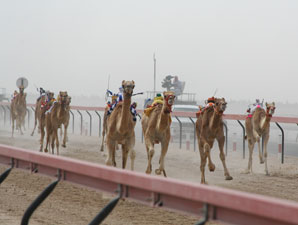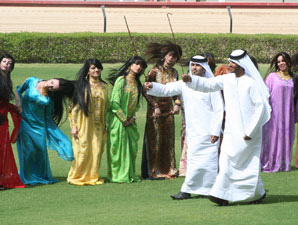 The racing aficionado's life is far from complete without a visit to a camel racetrack.
The racing aficionado's life is far from complete without a visit to a camel racetrack.
Sure, there might be no sight more compelling than a Thoroughbred in full flight. Curlin, for example, is the epitome of power and grace in one "complete package," as assistant trainer Scott Blasi likes to say.
Yet racing fans haven't truly lived until they've seen 20 or more camels thundering down a track, their big feet spraying dust behind them and the little robotic jockeys on their backs rhythmically swatting them with whips to go faster.
An army of sport utility vehicles surrounds the racetrack on both sides as managers of the camels drive along beside the racers, operating the robot remote controls and whooping with the action.
Sometimes a camel can run off from the field and win handily and sometimes there are tight finishes. Always there is excitement as the camels, who wear brightly colored blankets, weave down the stretch, some closing strongly and others tiring.
In between the action, there is ongoing entertainment as men dance and sing traditional songs while gesturing with their walking sticks and girls in colorful gowns swing their long black hair in transfixing time with the music.
In some ways, the few Westerners here on Friday afternoon at the new camel racetrack in Al Lisaili Village, about a half-hour drive from the center of Dubai, feel that they are intruding even though admission is open to all and is free. Any niggling doubts are dispelled when men emerge from the crowd and say, "Welcome," and "You may go anywhere to take pictures." Others have their sons bring over bottles of water when the afternoon heat reaches into the mid 90s.
Even when Dubai's crown prince, Sheikh Hamdan bin Mohammed al Maktoum-who is hosting this meet of several races for very young camels and whose image is everywhere on billboards and banners that flutter in the desert breezes-appears to present trophies, people are allowed to come close to the presentations. The owner of the biggest winner of the afternoon receives a magnificent gold trophy topped by a finely sculpted head of a camel.
With great pomp-more by far than at most Thoroughbred tracks-the first three finishers of each race are paraded before the crowd, their heads and necks dabbed with orange-colored paint to distinguish them. The music plays on and the dancing and singing continues. Watching all this unfold dramatically before the eyes is like being in a time machine to a different era or a culture machine to a world that is so different from, yet so similar to, our own.
Although it has been one of the heartbreaks of Dubai's progress that the camel racetrack at Nad Al Sheba - which stood directly across the street from the horse racetrack - was dismantled to make way for the building of the Meydan complex, visiting Al Lisaili has been a balm to the soul that has fanned a mysterious love affair with the camels.
In past years, it was such a delight to watch the Dubai World Cup (UAE-I) horses train at Nad Al Sheba as the sun rose, and then, while standing at the highest level in the grandstand, to turn around see the camels working out across the road. And it was always such a stamp of Middle Eastern reality to see the camels come trudging across the roadway at special crossings (and to know that if one was hit by a car there would be a very serious penalty to pay). Sometimes the early-morning sight of a camel being hauled in the back of a pickup truck would be a startling yet bemusing beginning to a day.
The "ships of the desert," as the camels are known, are just as much a part of the essence of this land and its rich heritage as horses are to the history of America. And the camels are prized here, with some top racing camels being worth several million dollars.
But the experience of the camel racing extravaganza is one that is beyond measure by money.




